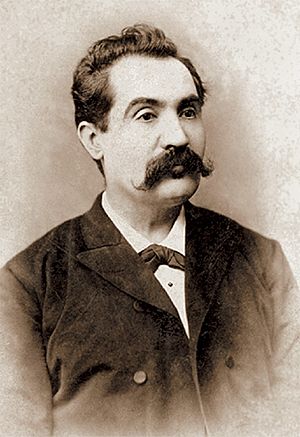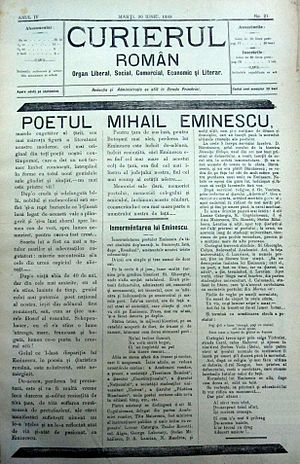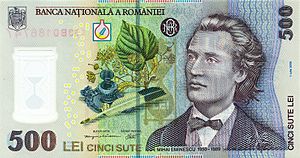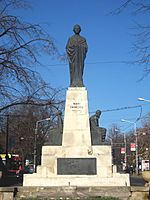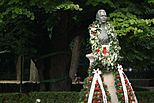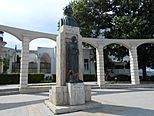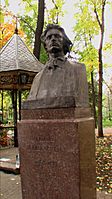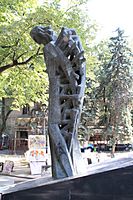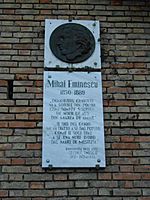Mihai Eminescu facts for kids
Quick facts for kids
Mihai Eminescu
|
|
|---|---|

Portrait of Mihai Eminescu. Photograph taken by Jan Tomas in Prague, 1869
|
|
| Born | Mihail Eminovici 15 January 1850 Botoșani, Principality of Moldavia |
| Died | 15 June 1889 (aged 39) Bucharest, Kingdom of Romania |
| Resting place | Bellu Cemetery, Bucharest |
| Occupation | |
| Language | Romanian |
| Citizenship |
|
| Education | |
| Genres | Poetry, short story |
| Subjects | Condition of genius, death, love, history, nature |
| Literary movement | Romanticism |
| Years active | 1866–1889 |
| Notable works | Luceafărul, Scrisoarea I |
| Partner | Veronica Micle |
| Relatives | Gheorghe Eminovici (father) Raluca Iurașcu (mother) Six brothers
Șerban
Nicolae (Nicu) Iorgu Ilie Matei Vasile Four sisters
Ruxandra
Maria (Marghioala) Harieta (Henrietta)/Aglae |
| Signature | |
 |
|
Mihai Eminescu (born Mihail Eminovici; January 15, 1850 – June 15, 1889) was a famous Romanian Romantic poet, novelist, and journalist. Many people consider him the most important Romanian poet ever. Eminescu was part of the Junimea literary group and worked as an editor for the newspaper Timpul ("The Time").
He published his first poem when he was 16 years old. At 19, he went to Vienna, Austria, to study. His many handwritten works, about 14,000 pages in 46 volumes, were given to the Romanian Academy in 1902. Some of his most famous poems include Luceafărul (The Evening Star), Odă în metru antic (Ode in Ancient Meter), and his five Letters. In his poems, he often wrote about big ideas, myths, and history.
Mihai Eminescu's father was Gheorghe Eminovici, who came from a noble family in Bukovina. His mother was Raluca Iurașcu. Although some records show different dates, his birth date is officially recognized as January 15, 1850, in Botoșani, Moldavia. His older sister, Aglae Drogli, confirmed he was born in Ipotești, a village near Botoșani.
Contents
A Poet's Journey: Mihai Eminescu's Life
Early Years and First Poems

Mihail, or Mihai as he preferred, was born in Botoșani, Moldavia. He spent his early childhood in Botoșani and Ipotești. From 1858 to 1866, he went to school in Cernăuți.
His first writing appeared in 1866. After his teacher, Aron Pumnul, passed away, students published a pamphlet called Lăcrămioarele învățăceilor gimnaziaști (The Tears of the Gymnasium Students). It included a poem titled La mormântul lui Aron Pumnul (At the Grave of Aron Pumnul), signed "M. Eminovici." Soon after, his poem De-aș avea (If I Had) was published in the magazine Familia. The editor, Iosif Vulcan, changed his last name to Eminescu, which sounded more Romanian.
In 1867, Eminescu joined a theater group as a clerk. He later moved to another leading Romanian theater group. He settled in Bucharest and worked at the National Theater. During this time, he kept writing and publishing poems. He also started a novel called Geniu pustiu (Wasted Genius), which was published after his death.
In 1869, he helped start a literary group called "Orient." This group wanted to collect Romanian folklore and historical literary documents. That summer, he met his brother Iorgu by chance but did not want to reconnect with his family. Later that year, he traveled to Cernăuţi and Iaşi. He reconnected with his family, and his father promised him money to study in Vienna. He continued to write poetry, including a leaflet for the death of Prince Barbu Dimitrie Știrbei.
Student Life and Journalism

From 1869 to 1872, Eminescu studied at the University of Vienna. He attended lectures as an "extraordinary auditor" because he didn't have a high school diploma. He was active in student life and became friends with Ioan Slavici. He also met Veronica Micle in Vienna. He started writing for Convorbiri Literare (Literary Conversations), a magazine edited by the Junimea (The Youth) cultural group. The leaders of Junimea, like Titu Maiorescu, greatly influenced Eminescu's life.
In 1870, Eminescu wrote articles about Romanians in the Austro-Hungarian Empire under the name "Varro." He then became a journalist for the newspaper Albina (The Bee). From 1872 to 1874, he continued his studies in Berlin, thanks to money from Junimea.
From 1874 to 1877, he worked in Iași. He was the director of the Central Library, a substitute teacher, and a school inspector. He also edited the newspaper Curierul de Iași (The Courier of Iaşi). All these jobs were possible because of his friendship with Titu Maiorescu. He continued to publish in Convorbiri Literare. He also became good friends with the writer Ion Creangă, whom he encouraged to write and introduced to the Junimea literary club.
In 1877, Eminescu moved to Bucharest. Until 1883, he worked as a journalist and then as editor-in-chief for the newspaper Timpul (The Time). During this time, he wrote many of his famous works, including Scrisorile, Luceafărul, and Odă în metru antic. He wrote many important articles when Romania was fighting the Ottoman Empire in the Russo-Turkish War. He also wrote about Romania gaining independence, but he disagreed with some conditions of the Treaty of Berlin.
Later Years and Passing
The 1880s were a difficult time for Eminescu, as his health declined. He passed away in 1889.
From 1883 to 1886, Eminescu received medical care in Austria and Italy. His friend, writer Ioan Slavici, said he seemed to recover well. In 1886, Eminescu became very ill and was treated by Romanian doctors. He was hospitalized in a hospice and later in a sanatorium in Bucharest.
Mihai Eminescu passed away on June 15, 1889, at the Caritas Institute in Bucharest. His last wish was for a glass of milk. The next day, he was officially declared deceased. His burial took place in Bellu Cemetery in Bucharest.
Mihai Eminescu's Works
Nicolae Iorga, a Romanian historian, believed Eminescu was like the "godfather" of the modern Romanian language, similar to how Shakespeare influenced English. Everyone agrees he is the greatest and most important Romanian poet.
The book Poems and Prose of Mihai Eminescu (edited by Kurt W. Treptow) contains many of his works translated into English.
His Poetry
Eminescu's poems cover many topics, from nature and love to anger and comments on society. He often wrote about his childhood with great fondness.
His poems have been translated into over 60 languages. His life and work have had a huge impact on Romanian culture. His poems are widely studied in Romanian schools.
Some of his most famous poems are:
- De-aș avea (If I Had), his first poem
- Ce-ți doresc eu ție, dulce Românie (What I Wish for You, Sweet Romania)
- Somnoroase păsărele (Sleepy Little Birds)
- Pe lângă plopii fără soț (Beside the Poplars Without a Mate)
- Doina (a traditional Romanian song type), 1884
- Lacul (The Lake), 1876
- Luceafărul (The Vesper), 1883
- Floare albastră (Blue Flower), 1884
- Dorința (Desire), 1884
- Sara pe deal (Evening on the Hill), 1885
- O, rămai (Oh, Linger On), 1884
- Epigonii (Epigones), 1884
- Scrisori (Letters or "Epistles-Satires")
- Și dacă (And if...), 1883
- Odă în metru antic (Ode in Ancient Meter), 1883
- Mai am un singur dor (I Have Yet One Desire), 1883
- Glossă (Gloss), 1883
- La Steaua (To The Star), 1886
- Memento mori, 1872
- Povestea magului călător în stele (The Story of the Magician Traveling Among Stars)
His Prose Works
- Sarmanul Dionis (Poor Dionis), 1872
- Cezara, 1876
- Avatarii Faraonului Tla (The Avatars of Pharaoh Tla), published after his death
- Geniu pustiu (Deserted Genius), a novel, published after his death
English Anthologies Featuring Eminescu
Eminescu's poems have been included in several English-language poetry collections:
- Testament – Anthology of Modern Romanian Verse (Bilingual Edition), edited by Daniel Ioniță, 2012 and 2015.
- Testament – Anthology of Romanian Verse – American Edition, edited by Daniel Ioniță, 2017.
- The Bessarabia of My Soul / Basarabia Sufletului Meu (Bilingual Edition), edited by Daniel Ioniță and Maria Tonu, 2018.
- Testament – 400 Years of Romanian Poetry (Bilingual Edition), edited by Daniel Ioniță, 2019.
- Romanian Poetry from its Origins to the Present (Bilingual Edition), edited by Daniel Ioniță, 2020.
Mihai Eminescu's Impact on Romanian Culture
When Eminescu was only 20, Titu Maiorescu, a leading literary critic, called him "a real poet." Eminescu's fame grew because he made the Romanian language richer. He used words from all Romanian regions and old texts, and he even created new words. He also used strong metaphors, which were rare in earlier Romanian poetry. He was one of the first Romanian writers whose work was published across all Romanian lands.
Eminescu called himself a Romantic poet. His early death and his free-spirited lifestyle made him seem like a true Romantic genius. By the late 1880s, he already had many loyal fans. His 1883 poem Luceafărul was so important that a new literary magazine was named after it.
Ion Luca Caragiale, another famous writer, described Eminescu as having a very unique personality. He said Eminescu often switched between being quiet and thoughtful, and being outgoing.
Titu Maiorescu described Eminescu as a dreamer who was not bothered by everyday problems. However, Eminescu's poems and letters show that he was often deeply affected by his feelings and experiences. His life was full of cycles of dreams and challenges from reality. These cycles could last from hours to months, depending on important events like his relationship with Veronica Micle or his political activities.
National Poet of Romania
Eminescu quickly became known as Romania's national poet. This was not just because he wrote during a time of national pride, but because Romanians everywhere saw him as an incredibly important writer. Even today, he is considered the national poet of Romania, Moldova, and Romanians living in Bukovina.
How Eminescu is Remembered Today
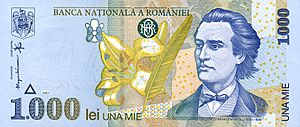
Mihai Eminescu is everywhere in Romania today. You can find his statues in many places. His face was on the 1000-lei banknotes and is now on the 500-lei banknote, which is the highest value Romanian banknote. The Eminescu's Linden Tree is a famous natural landmark. Many schools and other buildings are named after him.
His birth and death anniversaries are celebrated every year in many Romanian cities. These became national celebrations in 1989 (100 years after his death) and 2000 (150 years after his birth, called Eminescu's Year in Romania).
Some younger Romanian writers have tried to offer new ways of looking at Eminescu's work, which sometimes caused debate.
Eminescu's Global Recognition
- A monument dedicated to Eminescu and Allama Iqbal was built in Islamabad, Pakistan, in 2004. This shows the friendship between Pakistan and Romania and how poetry can connect different cultures.
- Composer Rodica Sutzu used Eminescu's words for her song “Gazel, opus 15.”
- In 2004, the Mihai Eminescu Statue was placed in Montreal, Quebec, Canada.
- On April 8, 2008, a crater on the planet Mercury was named after him.
- A street near the Romanian embassy in Sofia, Bulgaria, is named after Eminescu.
- In 2021, the Dutch artist Kasper Peters created a theater show called "Eminescu."
- On January 15, 2023, the first monument in Spain honoring Mihai Eminescu was put up in Rivas-Vaciamadrid. A memorial bench is in front of the library at Constitution Square.
- Monuments to Mihai Eminescu (selection)
-
Mihai Eminescu statue, Iași
-
Mihai Eminescu, monument by Oscar Han, Constanța
-
Mihai Eminescu statue, Chișinău, Moldova
Mihai Eminescu's Views
Because of his strong nationalistic views, Eminescu became an important figure for the Romanian right-wing.
After a period when his works were criticized, Romanian Communists later accepted Eminescu as a major Romanian poet. This happened partly because of his poem Împărat și proletar (Emperor and Proletarian). This poem was influenced by events in France in 1870–1871. Some parts of the poem were used to show Eminescu as a poet who cared about the working class.
It is also known that Eminescu held some views about Jewish people that were common in his time but are not accepted today.
See also
 In Spanish: Mihai Eminescu para niños
In Spanish: Mihai Eminescu para niños
- Mihai Eminescu National Theater


